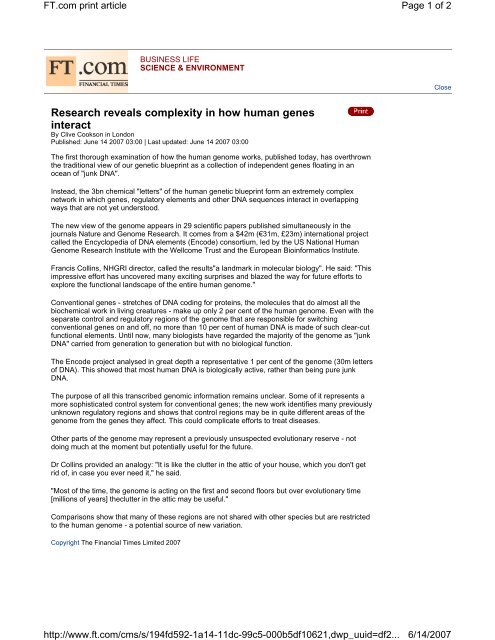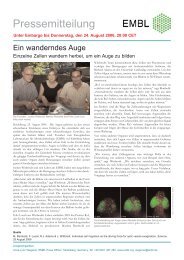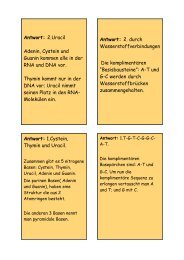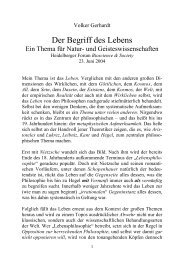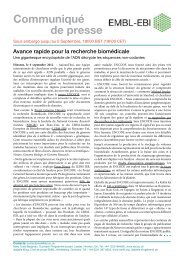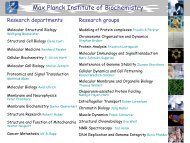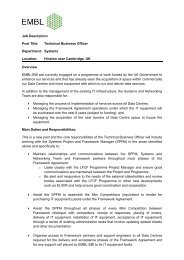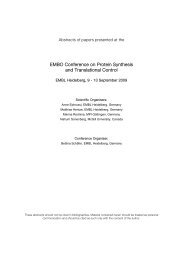Media Clips - EMBL
Media Clips - EMBL
Media Clips - EMBL
You also want an ePaper? Increase the reach of your titles
YUMPU automatically turns print PDFs into web optimized ePapers that Google loves.
FT.com print article<br />
Research reveals complexity in how human genes<br />
interact<br />
By Clive Cookson in London<br />
Published: June 14 2007 03:00 | Last updated: June 14 2007 03:00<br />
The first thorough examination of how the human genome works, published today, has overthrown<br />
the traditional view of our genetic blueprint as a collection of independent genes floating in an<br />
ocean of "junk DNA".<br />
Instead, the 3bn chemical "letters" of the human genetic blueprint form an extremely complex<br />
network in which genes, regulatory elements and other DNA sequences interact in overlapping<br />
ways that are not yet understood.<br />
The new view of the genome appears in 29 scientific papers published simultaneously in the<br />
journals Nature and Genome Research. It comes from a $42m (€31m, £23m) international project<br />
called the Encyclopedia of DNA elements (Encode) consortium, led by the US National Human<br />
Genome Research Institute with the Wellcome Trust and the European Bioinformatics Institute.<br />
Francis Collins, NHGRI director, called the results"a landmark in molecular biology". He said: "This<br />
impressive effort has uncovered many exciting surprises and blazed the way for future efforts to<br />
explore the functional landscape of the entire human genome."<br />
Conventional genes - stretches of DNA coding for proteins, the molecules that do almost all the<br />
biochemical work in living creatures - make up only 2 per cent of the human genome. Even with the<br />
separate control and regulatory regions of the genome that are responsible for switching<br />
conventional genes on and off, no more than 10 per cent of human DNA is made of such clear-cut<br />
functional elements. Until now, many biologists have regarded the majority of the genome as "junk<br />
DNA" carried from generation to generation but with no biological function.<br />
The Encode project analysed in great depth a representative 1 per cent of the genome (30m letters<br />
of DNA). This showed that most human DNA is biologically active, rather than being pure junk<br />
DNA.<br />
The purpose of all this transcribed genomic information remains unclear. Some of it represents a<br />
more sophisticated control system for conventional genes; the new work identifies many previously<br />
unknown regulatory regions and shows that control regions may be in quite different areas of the<br />
genome from the genes they affect. This could complicate efforts to treat diseases.<br />
Other parts of the genome may represent a previously unsuspected evolutionary reserve - not<br />
doing much at the moment but potentially useful for the future.<br />
Dr Collins provided an analogy: "It is like the clutter in the attic of your house, which you don't get<br />
rid of, in case you ever need it," he said.<br />
"Most of the time, the genome is acting on the first and second floors but over evolutionary time<br />
[millions of years] theclutter in the attic may be useful."<br />
Comparisons show that many of these regions are not shared with other species but are restricted<br />
to the human genome - a potential source of new variation.<br />
Copyright The Financial Times Limited 2007<br />
BUSINESS LIFE<br />
SCIENCE & ENVIRONMENT<br />
http://www.ft.com/cms/s/194fd592-1a14-11dc-99c5-000b5df10621,dwp_uuid=df2...<br />
Page 1 of 2<br />
Close<br />
6/14/2007


